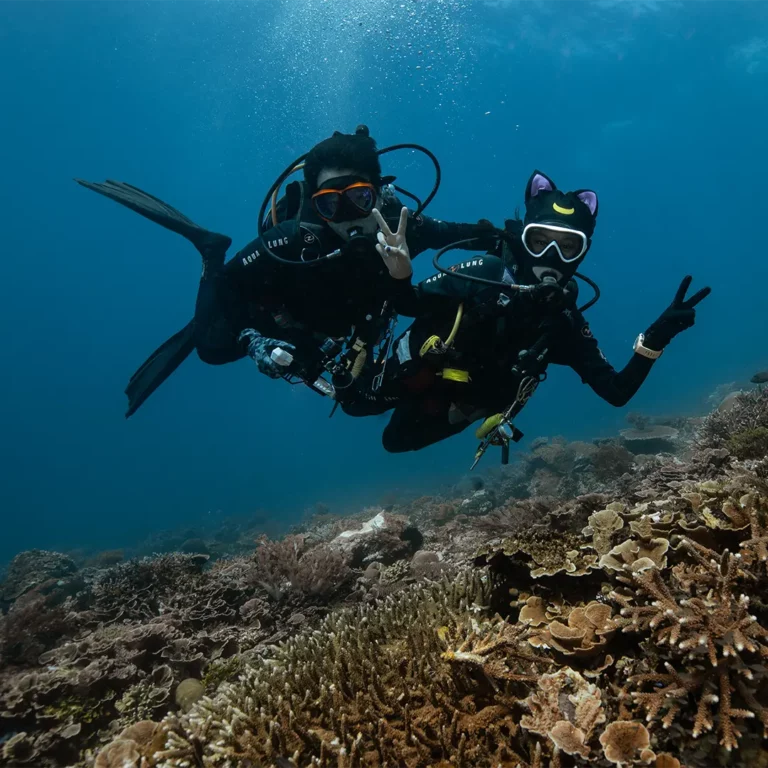Although familiar to the global diving community, the Ocean Sunfish is one of the least understood marine species. Its scientific name, Mola mola, comes from the Latin word meaning “millstone”, and refers to how this fish has a surface similar to millstone that is grey, rough, and rounded.
Ocean Sunfish are referred to as “moon fish”, “swimming head”, “self-head”, and “rolling car fish”, all in reference to their unique shape.
What is the Ocean Sunfish (Mola Mola)?
In English, this fish is usually called Ocean Sunfish. It is so named because of its basking behaviour near the surface of waters around the world. The Ocean Sunfish is not common despite its fame. In fact the Ocean Sunfish’s conservation status is listed as vulnerable on the International Union for the Conservation of Nature (IUCN) Red list. Despite this though, sightings of this animal are increasing which could possibly be due to the warming of Oceans caused by climate change. The Ocean Sunfish family belongs to the order Tetraodontiformes, which comprises pufferfish, as their facial features are comparable to these species.
Characteristics
This flat-shaped fish has no caudal fin, but rounded and sometimes scalloped tips rather than fins. The only way the fish moves throughout the water column is with its dorsal and anal fins, which are located at the top and bottom of its body. Ocean Sunfish can reach a weight of over 900 kilos or 2,000 pounds and an average length of 2 metres or six feet, making them one of the largest fish in the ocean. Even with these dimensions, these fish remain docile and pose no danger to humans in the water. They are also big travellers, swimming up to 26 kilometres (16 miles) per day.
Habitat
The Ocean Sunfish is a pelagic species that lives in tropical and temperate waters across the Earth. However, this fish lives at depths between 200 – 600 metres (660 to 2,000 feet) all day long. It exists in Australasia, Africa, South America, the Mediterranean or even Florida. Actually, its existence depends on a certain temperature. In fact, their distribution can basically be any Ocean in the entire globe other than the Arctic and Antarctic Seas. It will become disorientated and die if it stays in waters colder than 10 degrees celsius (50 F) for extended periods.
ALSO READ : 5 Biggest Threats that are Making Sea Turtles Extinct
Diet
Through its nutrient-deficient diet, the Ocean Sunfish must consume a very large amount of food to maintain its weight, which is in contrast to its large size. The Ocean Sunfish eats crustaceans, small fish, fish larvae, and even grasses as its food source, for which it needs to forage and hunt for its food at various ocean depths. Ocean Sunfish also prey on jellyfish, which is an important part of the marine ecosystem because it helps regulate jellyfish populations in various places to prevent invasive swarms.
Sunfish and Humans
People often consider these fish harmless, and many divers enjoy making friends with Sunfish in the ocean. However, sailors dislike these fish because Sunfish often collide with ships and damage them. Sunfish can even jump from the surface of the water to a height of 3 metres (10 feet) above the water, and then land with a splash of water to expel the parasites that infest their skin. If these gentle ocean giants are not jumping out of the water to clear parasites, they may also be seen flipping to one side on the surface of the water to allow seagulls to land on them and pick the parasites off.
Fishing
Marine Sunfish populations have been declining, largely due to unfavourable bycatch from gillnet fishing. This population decline is attributed to human predators.
Some countries, such as Taiwan and Japan, consider Ocean Sunfish meat a delicacy. Even its fins and internal organs are used in traditional medicine. Mola Mola’s main food is jellyfish, which also resembles plastic bags. This is bad news for the Sunfish as they often mistake the garbage for food, which when eaten makes them choke and suffocate.
Where Can We Find Mola Mola?
ALSO READ : 11 Interesting Things to Know About Seahorses
Let’s Find Mola Mola in Raja Ampat and Komodo Island with La Galigo Liveaboard!
The Ocean Sunfish (Mola mola) can be found in various regions around Indonesia. Here are some areas where you might encounter them:
Bali
- Bali, known for its rich marine biodiversity, is a popular location for spotting Ocean Sunfish. Divers and snorkelers often have the opportunity to see them in the waters around the island.
Nusa Penida
- Nusa Penida, an island southeast of Bali, is particularly famous for its Sunfish sightings. The waters surrounding Nusa Penida are considered a hotspot for observing these unique creatures.
Komodo National Park
- The waters around Komodo National Park, located in the Lesser Sunda Islands, are known for their diverse marine life. Ocean Sunfish can occasionally be seen in this area, especially during specific seasons. They more frequently can be found in the southern section of the park, where cooler water upwellings are more conducive to their feeding behaviour.
Raja Ampat
- Raja Ampat, situated in West Papua, is renowned for its stunning coral reefs and marine diversity. While not as common as in some other locations, Ocean Sunfish sightings have been reported in the waters around Raja Ampat.
Alor Archipelago
- The Alor Archipelago in East Nusa Tenggara is another region where Ocean Sunfish can occasionally be spotted. Divers exploring the waters of Alor may have the chance to encounter these fascinating fish.
Lembata Island
- Lembata Island, also in East Nusa Tenggara, is known for its deep-sea diving experiences. Ocean Sunfish may be encountered in the deeper waters around the island.
It’s important to note that the presence of Ocean Sunfish can vary, and sightings are not guaranteed. These fish are known to migrate across large distances, and their movements can be influenced by factors such as water temperature and the availability of food. If you’re specifically interested in observing Ocean Sunfish, it’s advisable to check with local dive operators or marine experts for the latest information on sightings and the best times to encounter them in a particular region.








